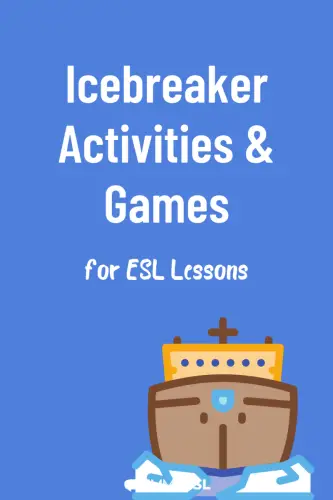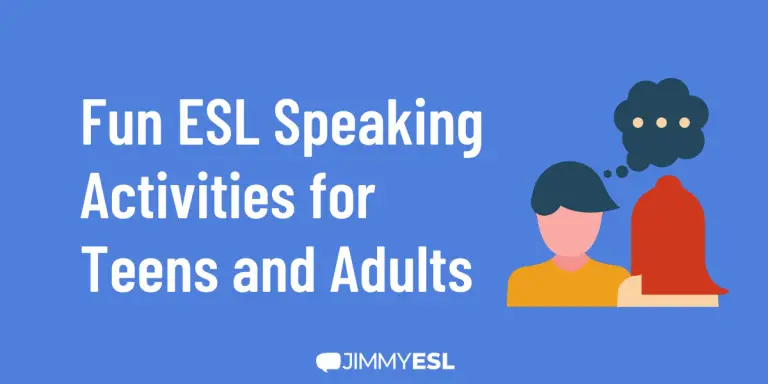ESL Icebreakers: 8 Games & Activities For Students of All Ages
Tell me if this sounds familiar to you:
You’re standing at the front of your ESL classroom (or sitting at your computer screen) and you’ve planned an amazing lesson out.
You have a great Powerpoint and you’re excited to teach, but when you ask the first question to the class…
Crickets.
Your students (or student) don’t say anything. They’re all avoiding eye contact, looking at the floor, or shuffling their feet.
Those awkward classroom moments are awful, but thankfully there’s a cure for them.
Icebreaker activities help your students become more comfortable in the classroom – and get to know one another, and you, a little more.
And the right icebreaker activity can transform your class, taking it from totally awkward to extremely fun and educational.
So, what is an ESL icebreaker activity?
Any game or activity you do at the beginning of class can be an icebreaker!
ESL icebreakers usually get your class speaking in English with one another so they start practicing using the language and getting comfortable in the classroom.
ESL icebreakers for kids usually involve more movement so the kids can get the wiggles out, while activities for adults might involve more free speaking and imaginative language.
Icebreakers for beginners may include more movement or simple activities involving identifying colors and shapes, while icebreakers for more advanced speakers will encourage students to form fuller sentences on their own.
Once you start implementing icebreakers in your class, you’ll get a better sense of what works for your learners.
The Best ESL Icebreakers for Any Age and Ability Level
Here are some of our favorite icebreakers for ESL students of all ages, in no particular order.
1. Name Game
- Student level: All levels
- Lesson type: Group
- Setting: In person/Online
This is a great game to play on the first day of class to help your students get to know each other.
Simply have your students toss a ball to each other. Each one says their own name and then the name of the person they’re tossing the ball to – and no one can toss the ball back to the person who tossed it to them.
You can also ditch the ball and have students say each other’s names if you’re teaching online.
This game isn’t terribly complicated, but it will get your students talking and help them all remember one another’s names!
2. Two Truths and a Lie
- Student level: Intermediate/Advanced
- Lesson type: Group or individual
- Setting: In person/Online
You may have played this game before.
The rules are simple: Each player comes up with three facts about themselves. Two are true, and one is a lie. Everyone has to guess which statement is the lie, and whoever guesses correctly gets to go next.
This game is great because it can be adapted to many levels and since the students learn about one another while also practicing their speaking and listening abilities.
3. I’m Going on a Picnic
- Student level: Intermediate
- Lesson type: Group
- Setting: In person/Online
This repeating game will have your class on the floor laughing while also challenging their memory skills and vocabulary.
The way it works is that you go around the circle and each participant says a picnic item in alphabetical order. Each participant adds on another item, while repeating the items mentioned before.
So if the first participant says “I’m going on a picnic and I’m bringing apples,” the second might say, “I’m going on a picnic and I’m bringing apples and a blanket,” and the third would say, “I’m going on a picnic and I’m bringing apples, a blanket, and cake,” and so on.
As the string of words to remember becomes longer and longer, your students will be giggling trying to remember everything they’re bringing.
4. Four Corners
- Student level: Beginner/Intermediate
- Lesson type: Group
- Setting: In person
If you’re looking for a listening comprehension game that incorporates movement, you can’t do better than this game.
In this game, you’ll ask students a question like “What’s your favorite food?” Then you’ll assign a different answer to each corner of the room, like noodles, pizza, burgers, and chicken.
Students will run to the corner of the room that corresponds with their answer.
You can have students choose the questions and possible answers for this game, too!
5. Jeopardy!
- Student level: Intermediate/Advanced
- Lesson type: Group/Individual
- Setting: In person/Online
This topical icebreaker is great to play online or in person. It’s better for intermediate to advanced students, but in general it’s pretty adaptable to meet your needs.
You’ll create questions ahead of time and your students will try to answer them individually or in teams, racking up points for each correct answer they get.
JeopardyLabs.com is a great online Jeopardy! quiz maker that you can use to make your very own Jeopardy! game.
You can make questions that are topical to your unit, about seasons or weather, or silly questions about your students themselves!
6. Sit Down If
- Student level: All levels
- Lesson type: Group
- Setting: In person/Online
This is an easy listening comprehension game to start class.
Everyone starts standing, and then the teacher (or an appointed student) starts making statements, like “Sit down if you have a younger sister” or “Sit down if you’re wearing shorts”.
If you’re in a zoom class, you can have students turn their camera off or lower their hands instead of sitting down.
The last person standing can be the next to make statements – or if your students are too young, you can continue to be the person making statements each round.
7. Organize Yourselves
- Student level: All levels
- Lesson type: Group
- Setting: In person
This game works best in person with a group of students.
Have the students line up in a row, organizing themselves by height or birthday…without speaking.
They may not get much speaking practice in this game, but they will have to figure out how to communicate with each other and get along.
8. Riddle Game
- Student level: Intermediate/Advanced
- Lesson type: Group/Individual
- Setting: In person/online
Students love playing this game, which can easily be done individually or in groups.
Choose a category like animals, and then have each student or team come up with something in the category and three clues to help others guess it.
For example, if a student chose an elephant as their animal, they might say “I’m gray…I have big floppy ears…I have a long trunk.”
Whoever chooses correctly will go next!
This is a great way to cover basic vocabulary like shapes and colors while also reviewing subjects you’ve learned in class.
Incorporating Icebreaker Games Into Your ESL Class
If you allot just 5-10 minutes at the beginning of your class for icebreakers, you’ll be astounded at the difference it makes.
Your students will look forward to playing games at the beginning of each class, and it will make them more excited about English lessons. You can find more tips to engage your students and build a community in classroom here.
You can also spend more time playing icebreakers at the beginning of the semester to get students excited, comfortable, and ready to learn.
Read this post for ideas on ESL warm-up games and activities.






